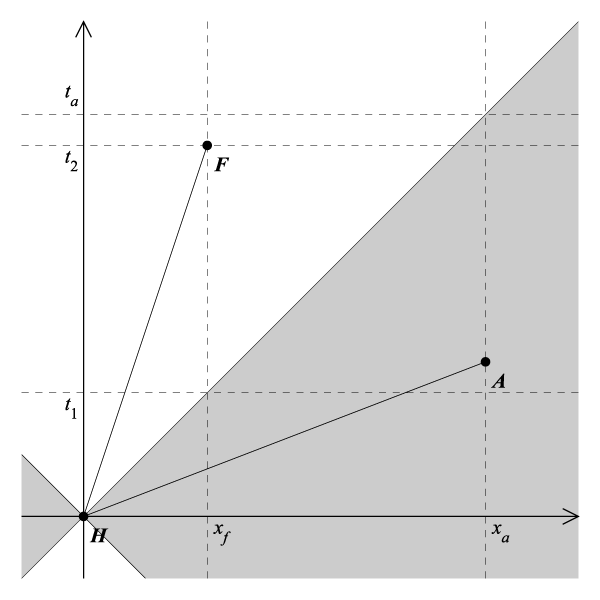Wormholes and Causality
After answering a poster's question in sci.physics, I got to thinking about the pseudo-FTL nature of wormholes. To make sure I'd gotten my logic straight I drew a Kerr diagram to help me, and I figured I might as well share it with you guys:
The vertical axis is time, the horizontal axis is space, and light travels at 45-degree angles. Point H is "here" (well, "here and now", because it pins down both space and time coordinates: x = t = 0). The shaded area is the region of spacetime outside of point H's light cone. Assume further that points F and A are wormholes which link back to point H. Can either of them exist?
First, consider the wormhole at point F. Its interval is timelike; that is, traveling through the wormhole displaces you more in time than in space. (All conventional travel is by nature timelike; standing still would be represented by a vertical line, since you're traveling in time but not at all in space.) If a traveler enters the wormhole at time t2, he will emerge at point H. Once there, he can send a signal via conventional means, or even grab a rocket and travel physically, into his own subjective past---in fact, to position x_f at any time between t1 and t2. Clearly, this would permit causality violations! Therefore, wormhole F is forbidden.
Now take a look at the wormhole at point A. Its interval is spacelike, which is usually associated with faster-than-light travel. Note that point A lies outside point H's light cone. Any traveler entering at A and emerging at H could not send a signal back to x_a, even at the speed of light, any sooner than t_a---after he had entered. Wormhole A is allowed, because it does not violate causality.
Finally, consider what happens if you try to take a wormhole like A and bring it back home to H. As you start moving A to the left, the line between A and H slopes upwards more and more. (The slope increases even faster if you're moving A at relativistic speeds, because a clock co-moving with it goes slower than the home-based one.) Eventually the connecting line approaches 45 degrees---i.e. A tries to enter H's light cone---and you get a Visser collapse.
Jim Wisniewski
The vertical axis is time, the horizontal axis is space, and light travels at 45-degree angles. Point H is "here" (well, "here and now", because it pins down both space and time coordinates: x = t = 0). The shaded area is the region of spacetime outside of point H's light cone. Assume further that points F and A are wormholes which link back to point H. Can either of them exist?
First, consider the wormhole at point F. Its interval is timelike; that is, traveling through the wormhole displaces you more in time than in space. (All conventional travel is by nature timelike; standing still would be represented by a vertical line, since you're traveling in time but not at all in space.) If a traveler enters the wormhole at time t2, he will emerge at point H. Once there, he can send a signal via conventional means, or even grab a rocket and travel physically, into his own subjective past---in fact, to position x_f at any time between t1 and t2. Clearly, this would permit causality violations! Therefore, wormhole F is forbidden.
Now take a look at the wormhole at point A. Its interval is spacelike, which is usually associated with faster-than-light travel. Note that point A lies outside point H's light cone. Any traveler entering at A and emerging at H could not send a signal back to x_a, even at the speed of light, any sooner than t_a---after he had entered. Wormhole A is allowed, because it does not violate causality.
Finally, consider what happens if you try to take a wormhole like A and bring it back home to H. As you start moving A to the left, the line between A and H slopes upwards more and more. (The slope increases even faster if you're moving A at relativistic speeds, because a clock co-moving with it goes slower than the home-based one.) Eventually the connecting line approaches 45 degrees---i.e. A tries to enter H's light cone---and you get a Visser collapse.
Jim Wisniewski

